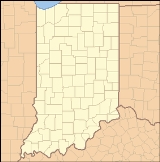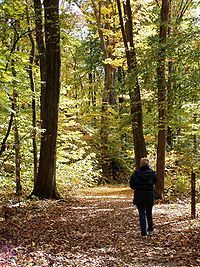
McCormick's Creek State Park
Encyclopedia
McCormick's Creek State Park is the oldest state park
in Indiana
, dedicated as on July 4, 1916, as part of the state's centennial celebration. It is located 14 miles (22.5 km) west of Bloomington, Indiana
in Owen County, Indiana
.
On May 12, 1916, it was suggested by a local newspaper editor to an Indiana state legislator that McCormick's Creek area would be a suitable location for a state park. German-born Indianapolis
businessman Richard Lieber
championed the idea of establishing a system of state parks for Indiana, and, after winning the property at auction with a bid of $5,250, received it from the Dr. Frederick Denkewalter estate. McCormick's Creek was formally opened on December 11, 1916; the centennial birthday of Indiana. In 1927 a naturalist program was started, a first for Indiana and the United States.
Much of the infrastructure of the park was built by the Civilian Conservation Corps
during Franklin D. Roosevelt
's New Deal
era, and many of the CCC-built structures, retaining walls, and elegant, arched limestone bridges remain in use today. The park entrance gatehouse and a stone arch bridge over McCormick's Creek are listed on the National Register of Historic Places
. There are eight numbered hiking trails in the park, accessing features and park attractions, which include a 90 feet (27.4 m) fire tower, a scenic ravine and waterfall, small cave, interesting sinkhole formations, and towering stands of second-growth Midwestern hardwoods. The park also features a fine system of equestrian paths.
Also on site is The Canyon Inn, a former sanitarium
that now hosts guests for the night. It has an Olympic-sized swimming pool. Overnight camping is also available. In addition, the Old State House quarry is a source of the Indiana limestone used in the Indiana State Capitol building.
 The heart of the park is McCormick's Creek Canyon. The upper levels of the canyon are around 700 feet (213.4 m) above sea levels, dropping to the West Fork of the White River
The heart of the park is McCormick's Creek Canyon. The upper levels of the canyon are around 700 feet (213.4 m) above sea levels, dropping to the West Fork of the White River
which is near 540 feet (164.6 m).
 Wolf Cave Nature Preserve
Wolf Cave Nature Preserve
Trail #5. The Wolf Cave Trail is considered to be of MODERATE difficulty. The 2 miles (3.2 km) trail is a loop through the Wolf Cave Nature Preserve. The trail is relatively level with a drop into a shallow valley. The trail begins at the Wolf Cave Parking Area. The forest along the route is a Beech-Maple forest
. Wolf Cave was formed by the collapse of a cave, leaving only the middle section 'the cave' still roofed.
McCormick's Creek Falls Trail
Trail #3. This short 0.8 miles (1.3 km) is considered RUGGED. The trail begins across from Canyon Inn and drops down before rising at the edge of McCormick's Creek Canyon. The trail access and overlook parking lot here before descending to the bottom of the canyon. There are no bridges across the creek. Fluctuating water levels makes some areas seasonably inaccessible. The trail ends at Stoney Restroom, a short walk back to the Canyon Inn.
McCormick's Cove Nature Preserve
State park
State parks are parks or other protected areas managed at the federated state level within those nations which use "state" as a political subdivision. State parks are typically established by a state to preserve a location on account of its natural beauty, historic interest, or recreational...
in Indiana
Indiana
Indiana is a US state, admitted to the United States as the 19th on December 11, 1816. It is located in the Midwestern United States and Great Lakes Region. With 6,483,802 residents, the state is ranked 15th in population and 16th in population density. Indiana is ranked 38th in land area and is...
, dedicated as on July 4, 1916, as part of the state's centennial celebration. It is located 14 miles (22.5 km) west of Bloomington, Indiana
Bloomington, Indiana
Bloomington is a city in and the county seat of Monroe County in the southern region of the U.S. state of Indiana. The population was 80,405 at the 2010 census....
in Owen County, Indiana
Owen County, Indiana
Owen County is a county located in the U.S. state of Indiana, and determined by the U.S. Census Bureau to include the mean center of U.S. population in 1920. As of 2010, the population was 21,575...
.
History
The park was named after the area's first settler John McCormick, who homesteaded on 100 acre (0.404686 km²) there in 1816, along the canyon by the waterfalls. Previously, the land was hunted by Miami Indians. McCormick's Creek Falls is the main attraction at McCormick's Creek State Park.On May 12, 1916, it was suggested by a local newspaper editor to an Indiana state legislator that McCormick's Creek area would be a suitable location for a state park. German-born Indianapolis
Indianapolis, Indiana
Indianapolis is the capital of the U.S. state of Indiana, and the county seat of Marion County, Indiana. As of the 2010 United States Census, the city's population is 839,489. It is by far Indiana's largest city and, as of the 2010 U.S...
businessman Richard Lieber
Richard Lieber
Richard Lieber was a German-American businessman who became the father of the Indiana state parks system. At his death, he could be considered the most powerful spokesman in the United States for the conservation of natural resources.-Early life:He was born into privilege in Düsseldorf, Germany,...
championed the idea of establishing a system of state parks for Indiana, and, after winning the property at auction with a bid of $5,250, received it from the Dr. Frederick Denkewalter estate. McCormick's Creek was formally opened on December 11, 1916; the centennial birthday of Indiana. In 1927 a naturalist program was started, a first for Indiana and the United States.
Much of the infrastructure of the park was built by the Civilian Conservation Corps
Civilian Conservation Corps
The Civilian Conservation Corps was a public work relief program that operated from 1933 to 1942 in the United States for unemployed, unmarried men from relief families, ages 18–25. A part of the New Deal of President Franklin D...
during Franklin D. Roosevelt
Franklin D. Roosevelt
Franklin Delano Roosevelt , also known by his initials, FDR, was the 32nd President of the United States and a central figure in world events during the mid-20th century, leading the United States during a time of worldwide economic crisis and world war...
's New Deal
New Deal
The New Deal was a series of economic programs implemented in the United States between 1933 and 1936. They were passed by the U.S. Congress during the first term of President Franklin D. Roosevelt. The programs were Roosevelt's responses to the Great Depression, and focused on what historians call...
era, and many of the CCC-built structures, retaining walls, and elegant, arched limestone bridges remain in use today. The park entrance gatehouse and a stone arch bridge over McCormick's Creek are listed on the National Register of Historic Places
National Register of Historic Places
The National Register of Historic Places is the United States government's official list of districts, sites, buildings, structures, and objects deemed worthy of preservation...
. There are eight numbered hiking trails in the park, accessing features and park attractions, which include a 90 feet (27.4 m) fire tower, a scenic ravine and waterfall, small cave, interesting sinkhole formations, and towering stands of second-growth Midwestern hardwoods. The park also features a fine system of equestrian paths.
Also on site is The Canyon Inn, a former sanitarium
Sanatorium
A sanatorium is a medical facility for long-term illness, most typically associated with treatment of tuberculosis before antibiotics...
that now hosts guests for the night. It has an Olympic-sized swimming pool. Overnight camping is also available. In addition, the Old State House quarry is a source of the Indiana limestone used in the Indiana State Capitol building.
Canyon

White River (Indiana)
The White River is a two-forked river that flows through central and southern Indiana and is the main tributary to the Wabash River. Via the west fork, considered to be the main stem of the river by the U.S. Board on Geographic Names, the White River is long.-West Fork:The West Fork, long, is...
which is near 540 feet (164.6 m).
Waterfall
McCormick's Creek waterfalls is a primary attraction. Indiana has few waterfalls due to the relatively flat topography, therefore, even a small falls, about 10 feet (3 m), is of interest.Hiking Trails

Trail #5. The Wolf Cave Trail is considered to be of MODERATE difficulty. The 2 miles (3.2 km) trail is a loop through the Wolf Cave Nature Preserve. The trail is relatively level with a drop into a shallow valley. The trail begins at the Wolf Cave Parking Area. The forest along the route is a Beech-Maple forest
Beech-maple forest
A beech-maple forest is a climax mesic closed canopy hardwood forest. It is primarily composed of American Beech and Sugar Maple trees which co-dominate the forest and which are the pinnacle of plant succession in their range...
. Wolf Cave was formed by the collapse of a cave, leaving only the middle section 'the cave' still roofed.
McCormick's Creek Falls Trail
Trail #3. This short 0.8 miles (1.3 km) is considered RUGGED. The trail begins across from Canyon Inn and drops down before rising at the edge of McCormick's Creek Canyon. The trail access and overlook parking lot here before descending to the bottom of the canyon. There are no bridges across the creek. Fluctuating water levels makes some areas seasonably inaccessible. The trail ends at Stoney Restroom, a short walk back to the Canyon Inn.
McCormick's Cove Nature Preserve

